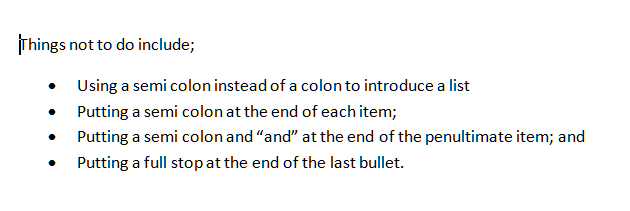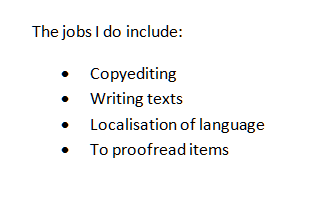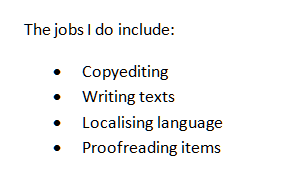Last week we talked about when to use bullet points and how to personalise them. This week, we’re going to have a look at the actual language of bullet points, including top tips on making them easy to understand for the reader. There are two parts to this: word forms / grammar and punctuation.
Punctuation in bullet points
Over recent years there has been a shift towards less punctuation and “cleaner” looking documents. I remember this being called “open” punctuation, and it’s the difference between typing an address as:
1, Avenue Gardens,
Brighton,
BN1 1AA.
and
1 Avenue Gardens
Brighton
BN1 1AA
Of course there is a place for punctuation, but it can get a bit messy looking, and I’m all for clean lines as long as you don’t forget your semi colons within normal runs of text!
So, here are some things not to do. We never introduce a list in a sentence with a semi colon, and we don’t introduce a bulleted or numbered list with one, either.
It used to be the case that we included semi colons and even “and”s at the end of every line. But I think that does look old-fashioned and cluttered nowadays …
Regarding the full stop at the end of the last bullet point … well, the jury is out on that one. It’s one of those style choices that don’t have a specific rule. I’ve checked in my New Oxford Style Manual and my Oxford Guide to Plain English: the former doesn’t talk about the punctuation much at all, and the latter has some general standards to consider following.
Here are my suggestions:
- If the bullet points come in the middle of a sentence, and it is still clear when you read that sentence even though it’s got bullets in the middle, you can
- start each bullet point with a lower case letter
- put a full stop at the end.
- If the bullet points are very short and don’t form a sentence, like this:
- Start with a capital
- Don’t add full stops
- Use full stops sparingly
- It is fine to add a full stop at the end of each bullet if the bullet points are long and include:
- More than one line of text which therefore forms a solid block when you look at it on the page.
- More than one sentence. It would look odd to have a full stop there and not here.
In summary:
But the single most important thing to do is KEEP IT CONSISTENT within each bulleted list! If you use capital letters or lower case letters to start each bullet, keep them the same throughout. If you end the first bullet with a full stop, end each of them with a full stop.
But of course, you can use different styles for different lists, as the context demands, although I’d be wary of having wildly different ones very close together, as it can look messy.
And this point on keeping it consistent brings me on to …
Grammar in bullet points
We insert bullet points into a text to make it more easy for the reader to understand. This means that the grammar within the bullet points should be consistent, so the reader doesn’t end up scratching their head and going over and over the same bit of text, trying to work it out.
Have a look at this example, and you’ll see what I mean:
Even if the reader can understand the basic sense of this, the uncomfortable disconnect between the different grammatical forms bring the reader’s attention to the form of the text and not the meaning of its content. And that’s not what good, clear writing should do. However, this is one of the most common mistakes I find in the text I proofread and edit. Especially if the bulleted list is long, the writer will lose track part way through and start going all inconsistent.
This is what that list above should look like:
Nice and tidy: everything following the same structure.
The grammar of bullet points must be consistent and matching so that the reader is not confused. It’s a different matter with the punctuation, which is, when it comes down to it, more of a matter of choice. Personally, I prefer capital letters and no full stop in my bullet points, which is why, if you’re my client and your bullet point punctuation is a little inconsistent, you’ll find me using that as standard!
So now you know all about how to insert and customise bulleted and numbered lists, and the grammar and punctuation to use with them! I hope you have found this helpful.
This is part of my series on how to avoid time-consuming “short cuts” and use Word in the right way to maximise your time and improve the look of your documents. Find all the short cuts here …
Do let me know if this has helped you – and do share with the buttons at the bottom of this article.




ianbraisby
November 28, 2012 at 6:48 pm
Great article Liz. I also constantly find myself translating and reviewing documents that have very inconsistent grammar and punctuation in their bulleted lists. The bit of your post I’d like to send in VERY LARGE LETTERS to some of my clients is that you can use different styles depending on the context – this is the kind of thing they sometimes claim is a “mistake” on my part. German clients in particular do not appreciate how flexible the English language is and like one word to equal one word in every situation or context, and for grammar and punctuation to be standardised and always right or wrong.
LikeLike
Liz at Libro
November 28, 2012 at 6:53 pm
Thanks for your comment, and I feel your pain: I have certain European clients for whom I have to remember to completely standardise my editing, rather than allowing synonyms, style choices and more flexibility. Keeps our brains busy!
I would like to send this post in VERY LARGE LETTERS to the clients who can’t keep their grammar consistent in their bullets … but then that would be the whole world!
LikeLike
hoendersop
November 30, 2012 at 7:38 am
Thanks, Liz. I like your no-nonsense approach. I wish each style guide could use this post as a reference.
LikeLike
Liz at Libro
November 30, 2012 at 7:39 am
Thank you for your kind comment. I try to make things clear and concise, and I’m glad I seem to be achieving that. Do have a wander around the other resources on the blog and feel free to suggest any you would like to read about in the future!
LikeLike
Phil
August 1, 2013 at 10:59 pm
Thanks for this post, we have “ping-ponged” too and fro on this during an edit project and now, the day before printing, I find your very useful advice! Thanks Liz, I’m going to browse your site in more depth as I’m certain there will be other gems to help my team!
LikeLike
Liz at Libro
August 2, 2013 at 8:06 am
Glad I could help and thanks for the comment. If you find anything missing that you want to know about, let me know and I’ll do my best to write about it soon!
LikeLike
Jose Villasenor
July 9, 2015 at 8:29 pm
I have a question. Is it grammatically permissible for the text of a bullet point to refer back in a “shorthand manner” to the text of an earlier bullet point in the series of bullet points or must the text of each bullet point be written so as to read as the second half of a complete sentence connected only to the text introducing the series of bullet points as the first half of the sentence?
The latter method seems cumbersome to me as requiring unnecessary repetition of text in different bullet points.
Thanks,
Joe V.
LikeLike
Liz Dexter
July 10, 2015 at 2:27 pm
There is usually a way to include any repeated text in the initial sentence, for example instead of
We are going to
– encourage people to save
– encourage people to buy new houses
– encourage people to decorate their houses
you could use
We are going to encourage people to
– save
– buy new houses
– decorate their houses
As long as what you are saying is clear and the bullets match grammatically, that is fine. I hope that helps!
LikeLike
Jose Villasenor
July 10, 2015 at 3:53 pm
Dear Ms. Dexter:
Thanks for the response. I should have provided the specific bullet points to which I was referring:
“The committee may:
• develop alternatives to involve parents in school activities;
• delegate to the parents so involved additional roles.”
My colleagues and I disagree as to the propriety of the “so involved” language in the second bullet, which refers back to the “to involve parents” language in the first bullet.
I am of the opinion that it is grammatically permissible for the second bullet to refer back to the text of the first bullet. My colleagues believe that each bullet must stand independently as a complete thought or idea when read together with the language introducing the bullets and that, when read as if the first bullet was absent, the second bullet is nonsensical.
Your opinion would be appreciated.
Thanks,
LikeLike
Liz Dexter
July 10, 2015 at 3:56 pm
Oh, I see. Yes, I agree with you, it’s fine to have one bullet depending on the previous one and referring to it. I would maybe run it past someone else to check that’s what they read it as, but yet – use the bullets to help you explain things; if they make it clearer, use them, if they don’t, then don’t. I think this makes it clearer, and I would certainly pass over it without correcting if it was in something I was editing.
An example might be instructions in a manual, which often use bullets for a list of tasks to be done one after the other.
LikeLike
Jose Villasenor
July 10, 2015 at 4:44 pm
Thanks, Ms, Dexter, much appreciated!
LikeLike